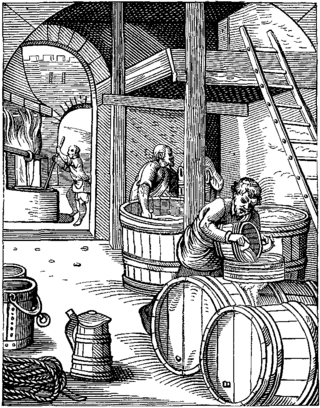
Beer is one of the oldest types of alcoholic drinks in the world, and the most widely consumed. It is the third most popular drink overall after potable water and tea. It is produced by the brewing and fermentation of starches, mainly derived from cereal grains—most commonly malted barley, though wheat, maize (corn), rice, and oats are also used. During the brewing process, fermentation of the starch sugars in the wort produces ethanol and carbonation in the resulting beer. Most modern beer is brewed with hops, which add bitterness and other flavours and act as a natural preservative and stabilising agent. Other flavouring agents such as gruit, herbs, or fruits may be included or used instead of hops. In commercial brewing, the natural carbonation effect is often removed during processing and replaced with forced carbonation.

Brewing is the production of beer by steeping a starch source in water and fermenting the resulting sweet liquid with yeast. It may be done in a brewery by a commercial brewer, at home by a homebrewer, or communally. Brewing has taken place since around the 6th millennium BC, and archaeological evidence suggests that emerging civilizations, including ancient Egypt, China, and Mesopotamia, brewed beer. Since the nineteenth century the brewing industry has been part of most western economies.

Draught beer, also spelt draft, is beer served from a cask or keg rather than from a bottle or can. Draught beer served from a pressurised keg is also known as keg beer.

Homebrewing is the brewing of beer or other alcoholic beverages on a small scale for personal, non-commercial purposes. Supplies, such as kits and fermentation tanks, can be purchased locally at specialty stores or online. Beer was brewed domestically for thousands of years before its commercial production, although its legality has varied according to local regulation. Homebrewing is closely related to the hobby of home distillation, the production of alcoholic spirits for personal consumption; however home distillation is generally more tightly regulated.

Old ale is a form of strong ale. The term is commonly applied to dark, malty beers in England, generally above 5% ABV, and also to dark ales of any strength in Australia. It is sometimes associated with stock ale or, archaically, keeping ale, in which the beer is held at the brewery. In modern times, the line has blurred between Old Ale and Barley wine.

A beer tap is a valve, specifically a tap, for controlling the release of beer. While other kinds of tap may be called faucet, valve or spigot, the use of tap for beer is almost universal. The word was originally coined for the wooden valve in traditional barrels. Beer served from a tap is largely known as draught beer, though beer served from a cask is more commonly called cask ale, while beer from a keg may specifically be called keg beer. Beer taps can be also used to serve similar drinks like cider or long drinks.

A keg is a small cask.

Beer has been brewed in England for thousands of years. As a beer brewing country, it is known for top fermented cask beer which finishes maturing in the cellar of the pub rather than at the brewery and is served with only natural carbonation.
A spile is a small wooden or metal peg used to control the flow of air into, and carbon dioxide out of, a cask of ale. Spiles can also be used to broach water from trees.

Timothy Taylor's is a family-owned regional brewery, founded in 1858 by Timothy Taylor, in Keighley, West Yorkshire, England. Timothy Taylor's moved to larger premises in 1863 at Knowle Spring in Keighley, where they remain.

Harvey's Brewery is a brewery in Lewes, East Sussex, England.

Bright beer is beer in which yeast is no longer in suspension. There are several methods used for clearing yeast from beer, from waiting for the yeast to drop of its own accord to filtering it.

London Pride is the flagship beer of Fuller's Brewery. It is sold both cask-conditioned and bottled. It has been brewed at the Griffin Brewery since 1958.

A beer engine is a device for pumping beer from a cask, usually located in a pub's cellar.
A cask breather is a type of demand valve used to serve draught beer. The cask breather enables the empty space created when beer is drawn from a beer cask to be filled with carbon dioxide from an external source. This prevents ambient air from being drawn into the cask, thus extending the life of the beer by preventing oxidation.

A brewery or brewing company is a business that makes and sells beer. The place at which beer is commercially made is either called a brewery or a beerhouse, where distinct sets of brewing equipment are called plant. The commercial brewing of beer has taken place since at least 2500 BC; in ancient Mesopotamia, brewers derived social sanction and divine protection from the goddess Ninkasi. Brewing was initially a cottage industry, with production taking place at home; by the ninth century, monasteries and farms would produce beer on a larger scale, selling the excess; and by the eleventh and twelfth centuries larger, dedicated breweries with eight to ten workers were being built.

The Society for the Preservation of Beers from the Wood (SPBW), founded in 1963, is the oldest consumer-based group interested in stimulating the brewing of, increasing the awareness of, and encouraging the drinking of traditional cask ale. The Society also supports and encourages the use of wooden casks for beer dispense.

Beer is often made from barley malt, water, hops and yeast and so is often suitable for vegans and vegetarians. Some beer brewers add finings to clarify the beer when racking into a barrel. Finings can include plant-derived products, like Irish moss, or animal-derived products, like isinglass and gelatin.
Capacities of brewery casks were formerly measured and standardised according to a specific system of English units. The system was originally based on the ale gallon of 282 cubic inches. In United Kingdom and its colonies, with the adoption of the imperial system in 1824, the units were redefined in terms of the slightly smaller imperial gallon. The older units continued in use in the United States.
Worthington's White Shield was an India pale ale (IPA) available principally in bottle conditioned form.
















